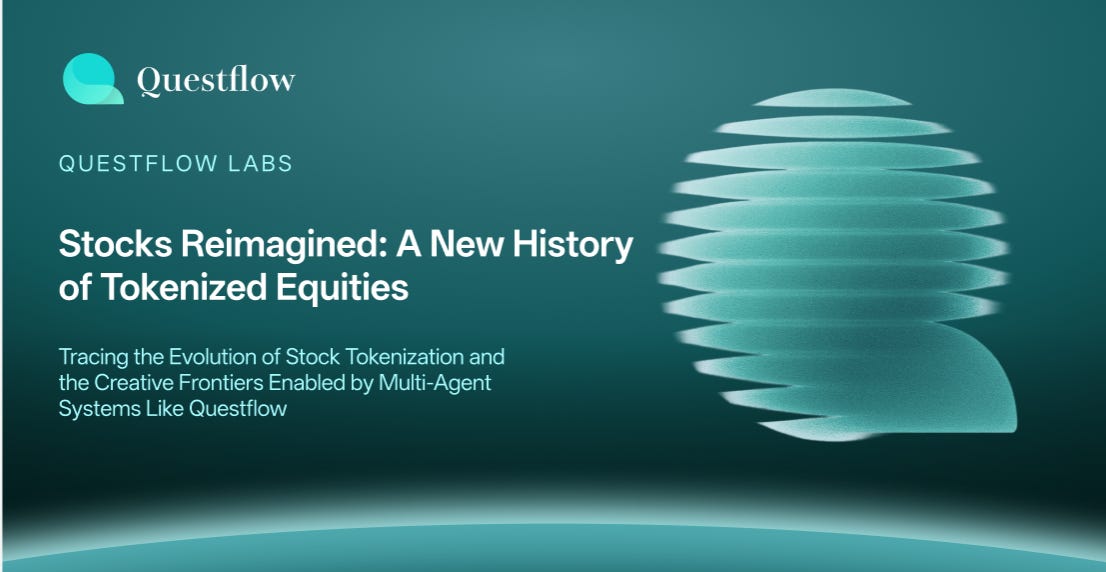Stocks Reimagined: A New History of Tokenized Equities
Tracing the Evolution of Stock Tokenization and the Creative Frontiers Enabled by Multi-Agent Systems Like Questflow
Introduction: From Wall Street to Web3
The traditional stock market has long served as the gateway to global wealth creation, but its infrastructure remains deeply entrenched in legacy systems—centralized brokers, delayed settlement, limited hours, and restricted international access. In contrast, the rise of tokenized stocks signals a new age of ownership: one that’s programmable, decentralized, and borderless.
While recent headlines highlight platforms like Robinhood offering tokenized shares of SpaceX and OpenAI to European users, this movement’s origins date back several years and include key experiments—some innovative, others cautionary.
In this article, we trace the evolution of stock tokenization from early pioneers like Mirror Protocol on Terra, to modern, regulation-conscious approaches. We then explore the future of this sector powered by multi-agent systems, including Questflow’s MAOP and QDP, which are reimagining what it means to invest, manage portfolios, and comply with complex international laws.
A Brief History of Tokenized Stocks
2020–2021: Terra’s Mirror Protocol and the Rise of Synthetic Equities
The Mirror Protocol launched on the Terra blockchain to allow users to trade synthetic assets mirroring the price of real-world stocks like Tesla, Apple, and Netflix. These were called mAssets.
Unlike tokenized shares backed 1:1 by custody, Mirror’s assets were algorithmically pegged using a system of overcollateralization.
It became popular among DeFi-native users, offering 24/7 trading, fractional shares, and access to U.S. equities for global users with just a wallet.
However, the collapse of Terra’s algorithmic stablecoin (UST) in 2022 caused a systemic failure. Mirror's model crumbled, exposing the risks of synthetic replication without transparency or regulatory clarity.
2022–2024: Cautious Institutional Experiments
Following Mirror’s collapse and the wider Terra ecosystem implosion, the market cooled. Focus shifted from synthetics to real-world asset (RWA) tokenization.
Franklin Templeton, Société Générale, and Hamilton Lane issued tokenized funds and bonds on Ethereum and Avalanche.
Platforms like Securitize began offering compliant tokenized equities with KYC/AML enforced at the token level.
The focus moved from yield-seeking DeFi users to regulated institutions and accredited investors.
2025: Retail Returns via Robinhood & CeFi 2.0
Robinhood launched tokenized shares of U.S. tech companies for European customers, with stablecoin payments, zero commissions, and real ownership.
These tokens, issued via partners, are backed 1:1 by underlying shares held in trust, not synthetic.
Kraken followed with xStocks, allowing 24/5 trading of tokenized equities—explicitly geofencing U.S. users to comply with regulations.
Tokenized RWAs surpassed $25 billion in value by mid-2025, led by treasuries, private equity, and stocks.
Tokenized Equities Today: Strengths and Weaknesses
Despite advantages, user experience, regulatory navigation, and agent-level decision making remain underdeveloped. That’s where multi-agent architecture—especially platforms like Questflow—comes in.
A New Architecture for Tokenized Investing
Multi-agent systems allow for task-specific, interoperable, and intelligent execution of complex workflows. Applied to tokenized stocks, this means:
Trading agents that parse news, sentiment, and technical signals.
Compliance agents that verify jurisdictional access and run KYC routines.
Portfolio agents that rebalance across RWAs and onchain yield products.
Risk agents that flag volatility or execute auto-exits based on thresholds.
Questflow’s MAOP (Multi-Agent Orchestration Protocol) enables these agents to:
Communicate securely
Share context/state
Operate within real-time logic flows
With QDP (Questflow Developer Platform), any developer can deploy a tokenized stock strategy by composing agents—without writing protocol-level logic.
Imagining the Near Future: Autonomous Use Cases
1. Cross-Market ETF Replication Agents track stock movements across exchanges, mimicking index ETFs with decentralized rebalancing strategies.
2. Real-Time Compliance Guardians Agents monitor jurisdictional law updates (e.g., MiCA, SEC) and adapt offerings accordingly.
3. Conversational Investing A user says: “Invest $1K in AI companies with low debt.” Agents scan tokenized listings and build a basket.
4. Automated Tax Optimization Agents calculate tax-efficient selling windows across markets and jurisdictions.
5. DAO Investment Swarms A decentralized fund governed by token holders where agents run portfolio ops, reporting, and voting facilitation.
6. Pre-IPO Access Agents Agents track tokenized equity launches like OpenAI shares, enabling access notifications, risk screening, and execution.
7. Smart Wallet & Custody Agents Tokens are held by agents with pre-set permissions, spending rules, and 2FA—all on-chain.
8. Tokenized Derivative Synthesis Agents create derivatives (calls, puts, leveraged tokens) from underlying tokenized equities for retail DeFi users.
Why Questflow? Creative Infrastructure for Financial Intelligence
Most existing solutions focus on token wrapping, custodial integration, or UI convenience. Questflow instead builds agent-native abstractions:
Protocol-native policy enforcement
Composable data + logic layers
User-owned agent swarms
It enables:
Developers to launch financial agents that adapt across regions
Communities to create investment games and airdrops linked to tokenized stocks
Investors to delegate strategy to multi-agent pods they trust
MAOP + QDP is not just infrastructure—it’s a programmable foundation for self-directed capital automation.
Conclusion: The Next Phase of Financial Infrastructure
Tokenizing equities is just the beginning. As AI, compliance tech, and autonomous software converge, capital itself becomes interactive, dynamic, and agent-driven. Questflow’s mission is to bring that vision into reality by:
Supporting onchain financial agents
Enabling global access to equity exposure
Lowering the friction between human intent and execution
The era of intelligent, decentralized investing has begun. And with multi-agent systems like Questflow, we’re not just digitizing stocks.
We’re liberating them.



